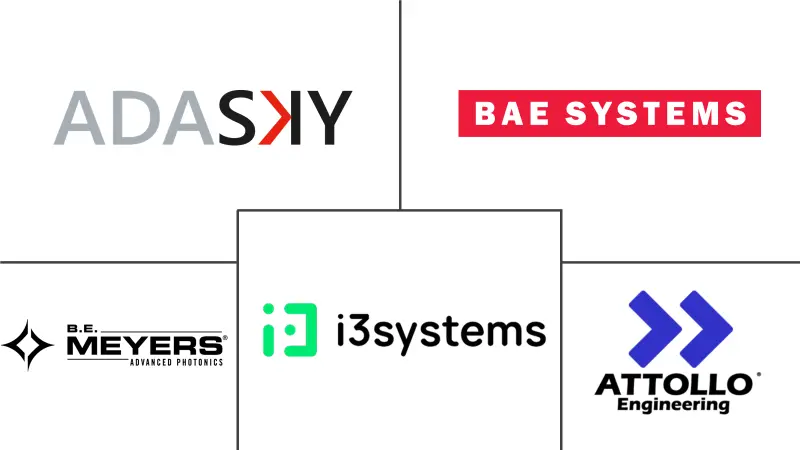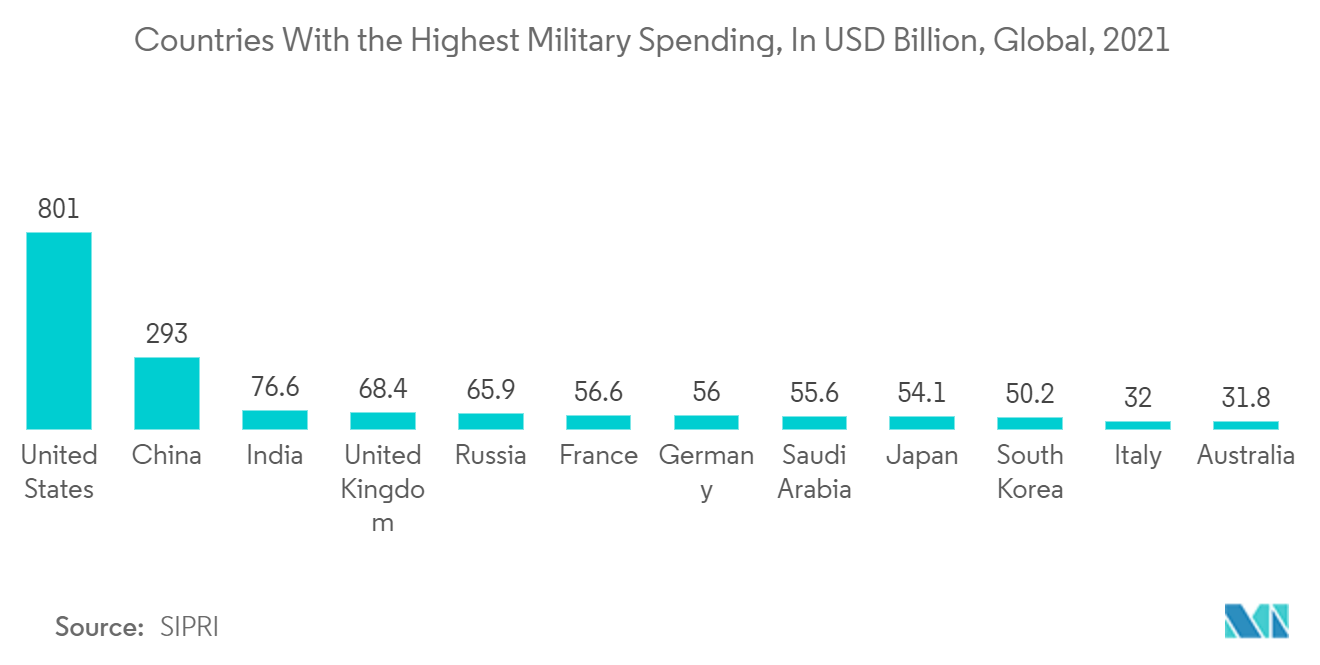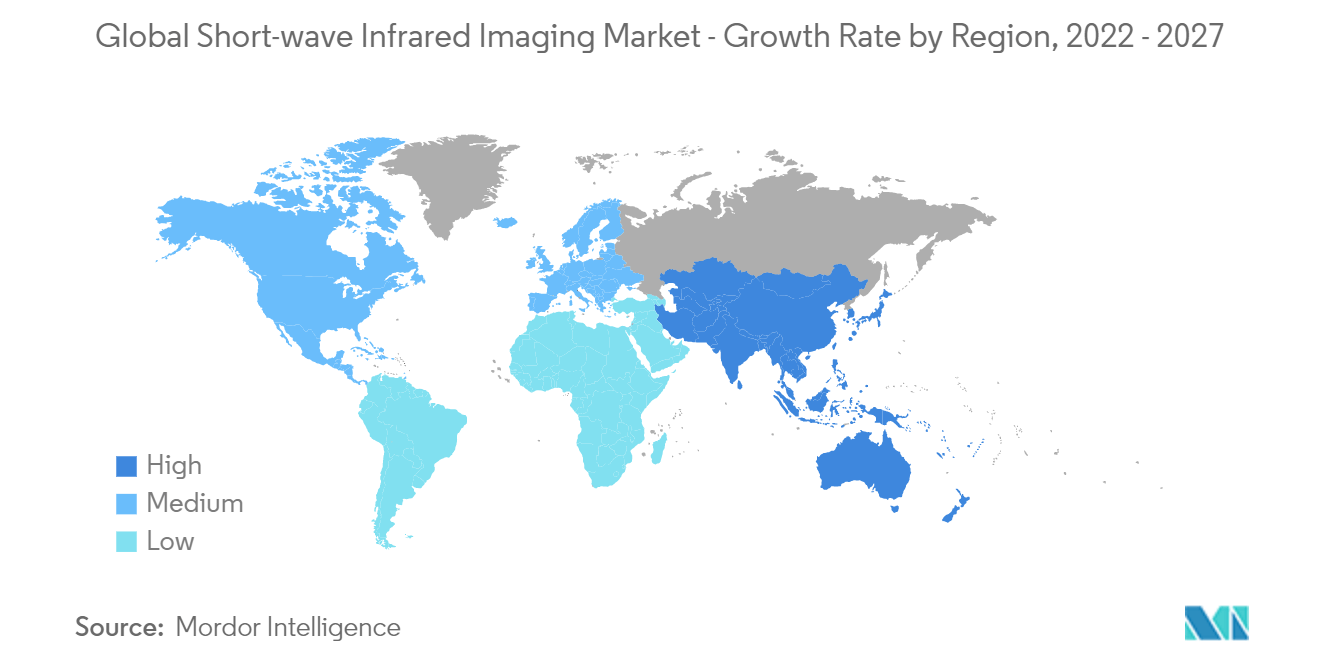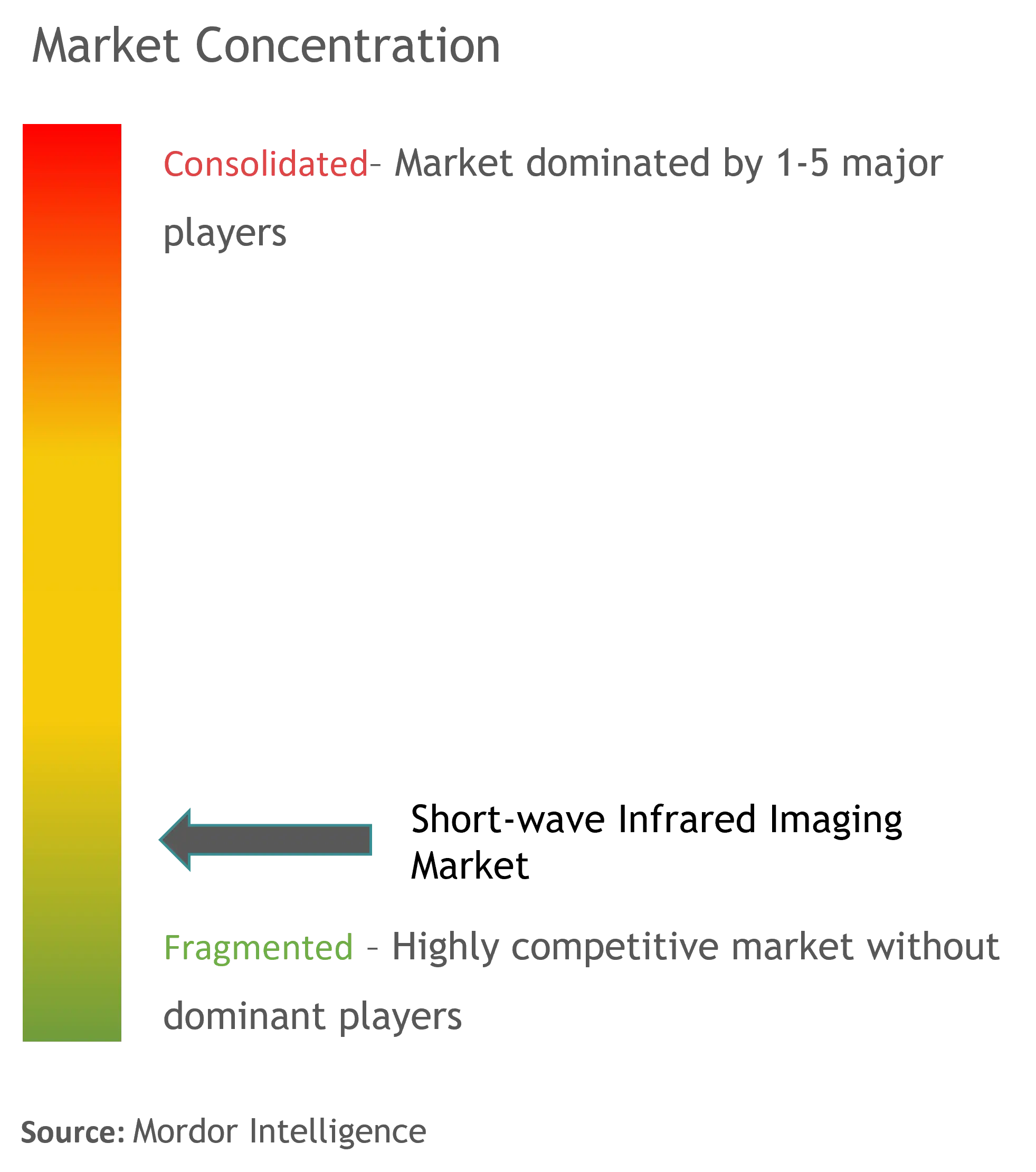
Short-wave Infrared Imaging Market Analysis
The Short-wave Infrared Imaging Market is expected to register a CAGR of 8.44% during the forecast period.
- Short-wave infrared imaging (SWIR) is an advanced technique for producing images based on radiation in the region of the electromagnetic spectrum, which is invisible to the naked eye. Short-wave infrared (SWIR) imaging is distinct because the radiation of interest is nearer to the visible spectrum but will still permit temperature sensing, usually over 100 °C.
- Short-wave infrared (SWIR) imaging consists of a wavelength band from 0.7 - 2.5μm. SWIR imaging is used in various applications, including solar cell inspection, electronic board inspection, identification and sorting, surveillance, anti-counterfeiting, process quality control, etc.
- Vehicle navigation is increasingly relying on SWIR cameras. With the rise of self-driving cars, SWIR technology can assist in navigating through fog, snow, dust, and rain. Recently, Israeli start-up TriEye introduced a dashboard-mounted SWIR camera for the consumer car market that can successfully navigate through snow, fog, dust, and rain, responding to the expanding use of SWIR cameras in autonomous vehicles.
- A lot of investments are going on around the globe to develop short-wave infrared imaging technology. For instance, in January 2022, Emberion, a developer of high-performance short-wave infrared imaging using nanomaterials, raised EUR 6 million to accelerate infrared imaging business growth.
- Recently, Israeli start-up TriEye introduced a dashboard-mounted SWIR camera for the consumer car market that can successfully navigate through snow, fog, dust, and rain, responding to the expanding use of SWIR cameras in autonomous vehicles. According to a NASDAQ, driverless automobiles will likely dominate the market by 2030. Thus, these investments are also likely to create a scope for the market studied in this sector.
- Due to ongoing testing, research, and collaborations between companies to develop autonomous cars, the number of autonomous vehicles is anticipated to grow robustly in the upcoming years. For instance, French autonomous vehicle maker, Navya introduced an all-electric and fully autonomous Autonom Cab, the first 100% autonomous robot taxi. Another company, Valeo, partnered with Docomo to jointly develop connected cars.
Short-wave Infrared Imaging Market Trends
Military & Defense Segment is Expected to Have a Significant Growth
- Infrared imaging is used in defense applications to enable high-resolution vision and identification in near and total darkness. The infrared (IR) wavelengths are essential for military and defense research and development because surveillance and targeting occur at night.
- The SWIR region bridges the gap between visible wavelengths and peak thermal sensitivity of infrared, scattering less than visible wavelengths and detecting low-level reflected light at longer distances, which is ideal for imaging through smoke and fog. Moreover, SWIR cameras are useful security and surveillance devices, sometimes by themselves and often combined with other imagers.
- In May 2021, a Melbourne-based firm received a contract to equip the Army drones with next-generation surveillance sensors to provide stable images day or night using infrared cameras. The sensor technology aims to enhance intelligence, surveillance, and reconnaissance (ISR) capability by leveraging an imaging system that uses electro-optical, short wave, and medium wave infrared cameras, along with laser range finding and target designation technology.
- Moreover, in November 2021, DARPA hired three groups to develop enhanced direct-view night-vision systems of a size and weight near those of typical eyeglasses as a part of its ENVision program. These three organizations will develop small and lightweight night-vision eyeglasses to extend visual access beyond near-infrared to include short-wave, mid-wave, and long-wave infrared spectral bands through a common aperture giving users access to spectral ranges from 1.5 to 12 microns.
- According to the UK parliament, defense spending in 2020/21 was GBP 42.4 billion in cash terms. This is a nominal rise of GBP 2.5 billion over the previous year and a real increase of GBP 1.7 billion. As a result, the yearly defense budget in 2024/25 will be GBP 6.2 billion more in cash terms than in 2020/21. However, the real worth of this spending rise is lower, especially in light of growing inflation. Defense spending is estimated to rise by GBP 1.5 billion when adjusted for inflation.
North America Accounts For the Largest Market Share
- US defense spending is the highest in the world and one of the prominent markets for SWIR cameras and technology. According to the US Department of Defense, compared to the FY 2020 authorized amount of USD 704.6B (excluding natural disaster emergency funds), the President's budget request of USD 705.4B represents a minor gain of around 0.1%. Given this reduced funding level, the Department made several difficult decisions to ensure that resources are focused on the Department's top priorities.
- To facilitate that decision-making, Secretary of Defense Esper launched a comprehensive Defense-Wide Review, which resulted in nearly USD 5.7 billion in savings for FY 2021, USD 0.2 billion in Working Capital Fund efficiencies, and another USD 2.1 billion in activities and functions realigned to the Services. This program enabled the Department to better resource higher-level National Defense Strategy (NDS) priorities.
- Companies in the region are seeking various investments from national and international firms to boost their infrared imaging business. For instance, in October 2021, SWIR Vision Systems Inc., a provider of image sensor solutions for industrial automation, autonomous vehicles, and other applications, has raised USD 5 million, which will be used to advance the company's CQD sensor solutions to grow the company's SWIR camera business in the global industrial and defense markets.
- In May 2021, Elbit Systems announced the next generation of its Advanced Multi-Sensor Payload System (AMPS NG), primarily adding Shortwave Infrared (SWIR) technology into the existing day CCD (Charge-Coupled Device) TV sensors and a unique, highly capable dual FLIR sensor design.
- Furthermore, in January 2022, TriEye, the mass-market Short-Wave Infrared (SWIR) sensing technology provider, announced the collaboration with Hitachi Astemo, a supplier of automotive products. The companies will work together to further enhance the capabilities of advanced driver assistance systems (ADAS) for adverse weather and low-light conditions by accelerating the launch of TriEye technology.
Short-wave Infrared Imaging Industry Overview
The Short-wave Infrared Imaging Market is highly competitive, with several local and international players active. International participants operate in the countries through partnerships with local players. With the market expected to broaden and yield more opportunities, more players will enter the market soon. Key players in the market include BAE Systems, B.E Meyers & Co., and Attollo Engineering, among others. The recent developments in the market are -
- February 2022 - Espoo, Finland-based Emberion announced that the company had raised EUR 6 million in funding to address the needs of the machine vision and surveillance markets for VIS-SWIR (Visible/Short Wave Infrared) cameras with broad-spectrum and wide dynamic range imaging performance.
- November 2021 - TriEye, a Short-Wave Infrared (SWIR) sensing technology provider, has received USD 74 million in funding from Intel, Samsung, and Porsche to commercialize a type of sensing technology that can be used to help autonomous and driver assistance systems to see better in adverse conditions.
Short-wave Infrared Imaging Market Leaders
-
B.E Meyers & Co.
-
i3 system
-
Attollo Engineering
-
BAE Systems
-
Adasky, Ltd.
- *Disclaimer: Major Players sorted in no particular order
Short-wave Infrared Imaging Market News
- January 2022 - Attollo Engineering, a supplier of infrared imaging solutions, introduced a low-cost, miniature Shortwave Infrared (SWIR) QVGA camera. The miniature Phoenix QVGA SWIR Camera is available at a low cost of USD 4900. Featuring the smallest SWIR sensor available, the innovative camera is superior for applications that require low size, weight, and power (low-SWaP).
Short-wave Infrared Imaging Industry Segmentation
The market study analyses the market trends and opportunities for different types of short-wave infrared imaging, such as 1 micron, 1.7 micron, and 2.1 micron, that are used in the various end-user industries in multiple regions. Further, the study analyzes the impact of COVID-19 on the market players and its stakeholders across the supply chain. Additionally, the disruption factors impacting the market's growth in the near future have been covered in the study regarding drivers and restraints.
| By Wavelength | 1 micron |
| 1.7 micron | |
| 2.1 micron | |
| By Type of Sensors | Line detectors |
| Imagers | |
| By Level of Integration | Imagers/ Line detectors |
| Cameras/Systems | |
| By End-User Industries | Military & Defense |
| Healthcare & Research | |
| Automotive | |
| Other End-user Industries | |
| By Geography | North America |
| Asia Pacific | |
| Europe | |
| Latin America | |
| Middle East and Africa |
Short-wave Infrared Imaging Market Research FAQs
What is the current Short-wave Infrared Imaging Market size?
The Short-wave Infrared Imaging Market is projected to register a CAGR of 8.44% during the forecast period (2025-2030)
Who are the key players in Short-wave Infrared Imaging Market?
B.E Meyers & Co., i3 system, Attollo Engineering, BAE Systems and Adasky, Ltd. are the major companies operating in the Short-wave Infrared Imaging Market.
Which is the fastest growing region in Short-wave Infrared Imaging Market?
Asia-Pacific is estimated to grow at the highest CAGR over the forecast period (2025-2030).
Which region has the biggest share in Short-wave Infrared Imaging Market?
In 2025, the North America accounts for the largest market share in Short-wave Infrared Imaging Market.
What years does this Short-wave Infrared Imaging Market cover?
The report covers the Short-wave Infrared Imaging Market historical market size for years: 2019, 2020, 2021, 2022, 2023 and 2024. The report also forecasts the Short-wave Infrared Imaging Market size for years: 2025, 2026, 2027, 2028, 2029 and 2030.
Our Best Selling Reports
Short-wave Infrared Imaging Industry Report
Statistics for the 2025 Short-wave Infrared Imaging market share, size and revenue growth rate, created by Mordor Intelligence™ Industry Reports. Short-wave Infrared Imaging analysis includes a market forecast outlook for 2025 to 2030 and historical overview. Get a sample of this industry analysis as a free report PDF download.






